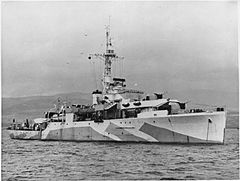Yangtze incident

HMS Amethyst, photographed during the Second World War
|
|
| Date | April 20 – July 30, 1949 |
|---|---|
| Location | Jiangyin, China |
| Coordinates | 31°56′00″N 120°10′00″E / 31.9333°N 120.1667°ECoordinates: 31°56′00″N 120°10′00″E / 31.9333°N 120.1667°E |
| Also known as | Yangtze Incident |
| Deaths | 22 |
| Non-fatal injuries | 31 |
The Amethyst Incident, also known as the Yangtze Incident, in 1949 involved the British Royal Navy ship HMS Amethyst being trapped on the Yangtze River for three months, during the Chinese Civil War.
On 20 April 1949, HMS Amethyst, commanded by Lieutenant Commander Bernard Skinner, was on her way from Shanghai to Nanking to replace Consort, which was standing as guard ship for the British Embassy there during the Chinese Civil War between the nationalist Kuomintang led Republic of China and the Communist Party led People's Republic of China. According to the Royal Navy, at around 08:31, after a burst of small arms fire, a People's Liberation Army (PLA) field gun battery on the north bank of the river fired a salvo of ten shells, which fell well short of the ship, and was assumed to be part of a regular bombardment of Nationalist forces on the south bank. Speed was increased, and large Union flags were unfurled on either side of the ship, after which there was no more firing from this battery.
At 09:30, as the frigate approached Kiangyin (Jiangyin) further up the river, she came under sustained fire from a second PLA battery. The first shell passed over the ship, then the bridge, wheelhouse and low power room were hit in quick succession, Lt Cdr Skinner was mortally wounded, and all the bridge personnel were disabled. The coxswain on the wheel, Leading Seaman Leslie Frank, was seriously injured and as a result the ship slewed to port and grounded on the bank before control of the ship was regained. Before the ship grounded, the order to open fire had been given, but when the director layer pulled the firing trigger, nothing happened, because the firing circuits were disabled when the low power room was hit. First Lieutenant Geoffrey L. Weston assumed command of the vessel, although also wounded himself. PLA shells exploded in the sick bay, the port engine room, and finally the generator, just after the injured Weston's last transmission: "Under heavy fire. Am aground in approx. position 31.10' North 119.50' East. Large number of casualties".
...
Wikipedia
